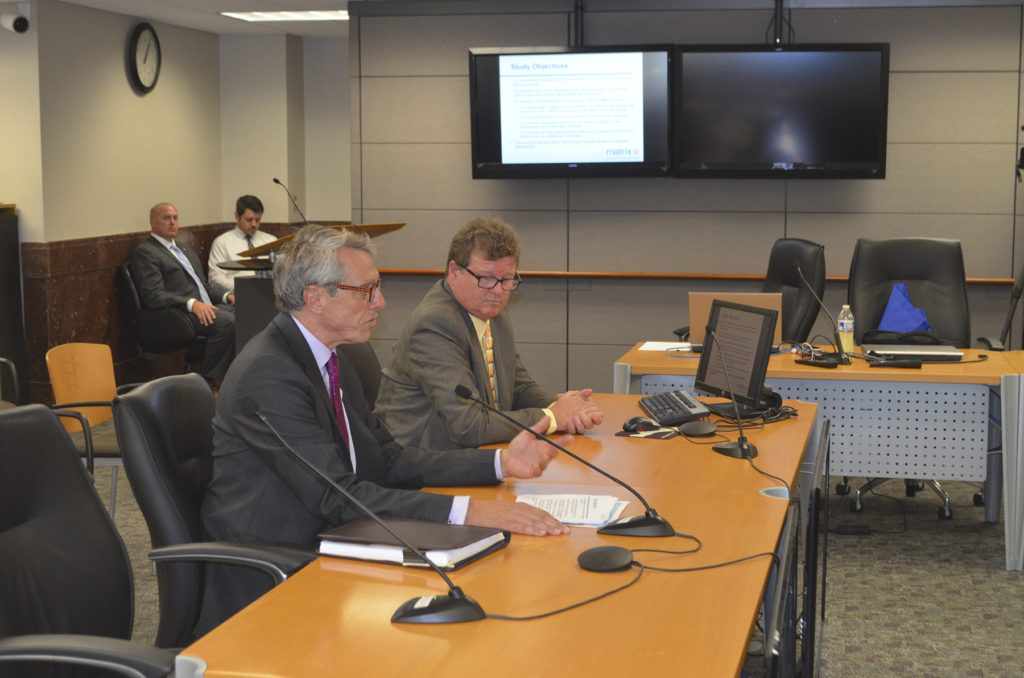
By Paul Thompson
Northeast News
The hiring of dozens of additional non-sworn personnel is just one way that consultants say the Kansas City, Missouri Police Department can become more efficient.
Richard Brady, the President of Matrix Consulting Group, joined the KCMO City Council’s business session on Thursday, August 3 to discuss the police staffing study that was recently conducted by his firm. Though details of the study have previously been reported in the media, this was the first opportunity for City Council as a collective body to hear from the consulting group.
In the course of their work, Matrix Consulting received input from more than 1,000 police department employees. Brady told the Council that the 59% response rate is considered an exceptional level of feedback. While most employee respondents indicated that the department provides high levels of service to Kansas City residents, the majority also reported that the Department has insufficient staff to effectively handle “expected levels of service” as it relates to patrol duties.
A majority of respondents also said that the police department has too many command staff. The staffing study bore that belief out; consultants found that Kansas City has one sergeant for every 4.6 officers. A study overview stated that the best practice is one sergeant for every 6-9 officers. The consulting group suggested that reducing the number of sergeants would help the department meet “much of the patrol staffing gap.”
Another important takeaway from the consulting firm is that many roles currently filled by police officers with a gun and a badge could be better filled by civilian employees. In Brady’s parlance, the department needs to be “civilianized.” He used KCPD’s local crime lab as an example.
“While most of the crime analysts are civilians, there a few that aren’t. All of them could be civilianized,” Brady said. “We’re not just talking about section and unit heads here, but also assistants to section and unit heads.”
As presently staffed, the department’s crime lab doesn’t have enough staff to keep up with the case load. Brady told Council members that the lab currently has a backlog that is thousands of cases deep. What’s more, the consultant’s study indicated that there is no hope to catch up on the backlog as staffing is presently constructed.
Ultimately, the staffing study recommends adding 42 civilian personnel to Administration, 21 to Patrol (15 of those additional civilian Patrol positions are in parking control; currently there are 5 in parking control w/ two supervisors, all civilians), nine to Investigations, nine to the Office of the Chief, four to Professional Development and Research, and three to Executive Services. To accommodate the additional civilian staff, the study recommends reducing the amount of sworn personnel by 13 in Administration, nine in the Office of the Chief, seven in Executive Services, and two in the Professional Development and Research Bureau. The recommendation further calls for one additional sworn officer in Patrol and no change to sworn personnel in Investigations. In total, the study recommends increasing police department staffing by 58 employees.
This isn’t the first time that the civilianization of the Kansas City, Missouri Police Department has been recommended. In September of 1998, the KCMO Auditor’s Office released a special report that highlighted ‘Opportunities for Civilianization” within the department. In the introduction to that document, the City Auditor – eventual Mayor Mark Funkhouser, incidentally – recommended hiring dozens of private citizens to fill positions occupied by sworn personnel.
“The Kansas City, Missouri Police Department has about 80 sworn officers, in ranks from police officer to major, in positions that do not require sworn powers,” Funkhouser wrote. “We recommend placing civilians in these positions and reassigning the sworn positions to law enforcement activities in the Patrol Bureau. By doing so, the Police Department can begin to reduce blackout and give officers more time for community policing.”
Funkhouser would go on to estimate in that special report that placing civilians in “administrative and support functions” would be cheaper and more effective for the department. The recommendation, in Funkhouser’s estimation, would “reduce the cost of these functions by about $1 million.”
“In other words,” Funkhouser wrote, “we propose that the department spend about $3 million on additional civilians, in order to free up about $4 million worth of law enforcement personnel.”
The final attachment to that 1998 special report is an appendix from then Chief of Police Floyd O. Barch.
“First, I want to let you know that the command staff of the Kansas City, Missouri Police Department wholeheartedly supports the concept of civilianization,” Barch wrote.
“You will note that we have supported civilianization from our past efforts in that since 1972 we have converted approximately one hundred sixty-nine (169) positions from sworn to civilian,” Barch later added.
Funkhouser’s special report is just one of at least nine audit reports or memos filed by the Auditor’s Office regarding the Kansas City, Missouri Police Department since it’s release in 1998. Nearly 20 years later, however, the City has received a similar recommendation from an objective, third-party source.
KCPD veterans approached by the Northeast News said that significant civilianization of the department did occur during the tenure of Chief Jim Corwin, who led the department from 2004 until 2011. The September 2011 edition of The Informant – KCPD’s official newsletter – praised Corwin for his Blueprint for the Future project, which “brought outside auditors to the department to analyze KCPD’s processes” and submit recommendations.
“Nine task forces comprising nearly 200 department members took up those recommendations, studied them and worked to get them implemented,” the article stated.
Though former Chief Barch suggested that KCPD has been civilianizing its ranks for several decades, the most recent staffing study nevertheless states that more civilianization is necessary. A shift to more civilian personnel would require the cooperation of KCPD leaders – including new Chief of Police Rick Smith, who is set to begin the job on August 15 – and the Board of Police Commissioners, the latter of which is currently going through a substantial shift in membership.
If more positions are civilianized, Brady noted, sworn officers can be reassigned to positions where they could conduct more proactive policing measures. The staffing study found that proactivity in the police department was statistically insufficient, and sometimes alarmingly so. At one point during the presentation, Brady noted that the east side of Kansas City has “essentially no proactivity on a 24-hour basis.”
One way proactive policing practicing could be increased, Brady suggested, is by having only one officer in each police vehicle, resulting in more police cars on the street. Brady further suggested that the department has enough vehicles in the fleet to accomplish this goal without purchasing any more cars.
“Proactivity is at 10% or less late at night or early in the morning,” Brady said. “You can address a lot of those issues by splitting two-person cars up.”
Brady suggested that the greatest need for additional proactivity is in the urban core.
“The inner city and other areas are not getting proactivity where there should be proactivity,” he said.
The staffing study further recommended that the Kansas City No Violence Alliance commit more resources to focused deterrence and that the police department continue to work with the City to pinpoint additional opportunities to share services.


















